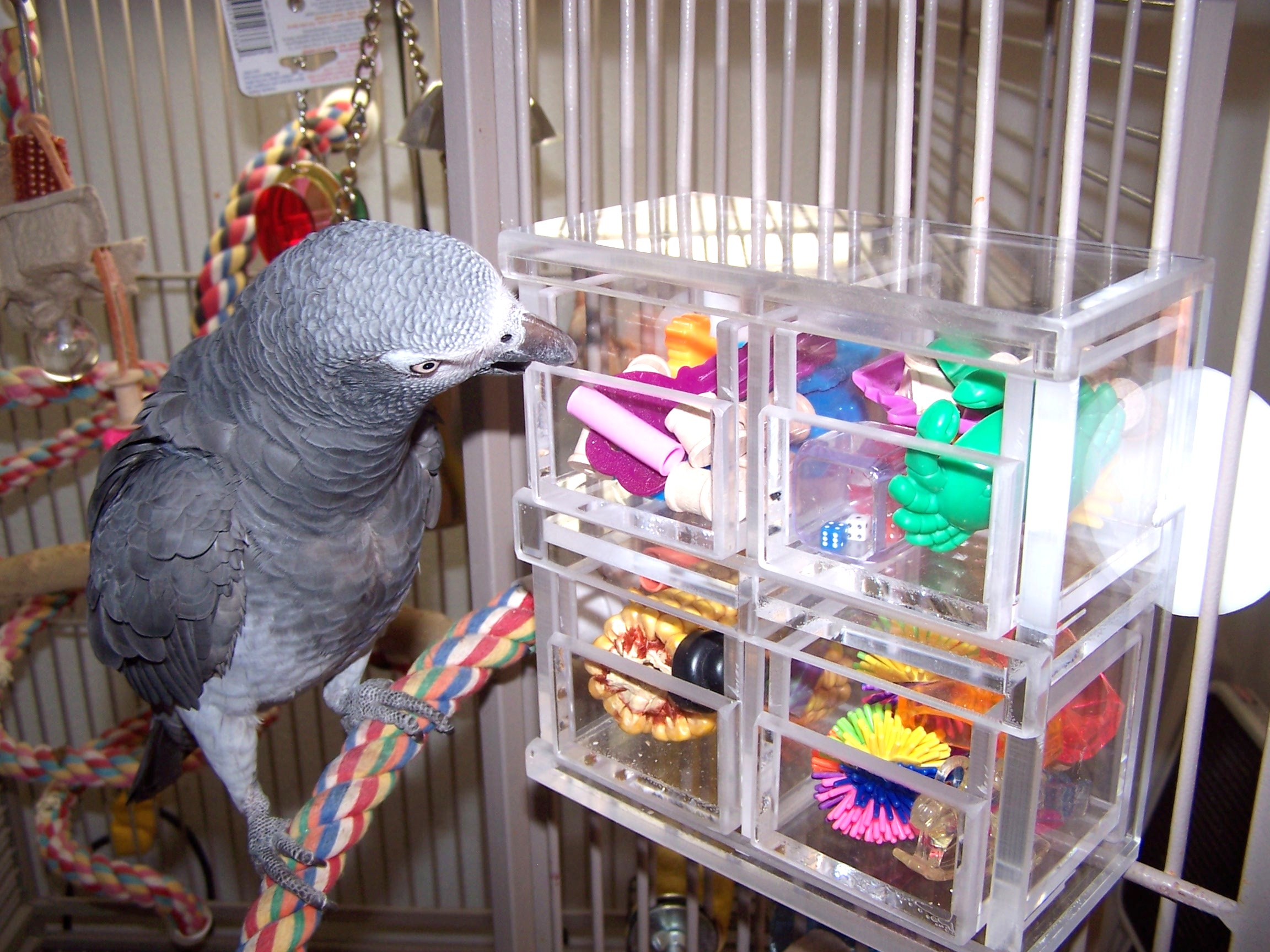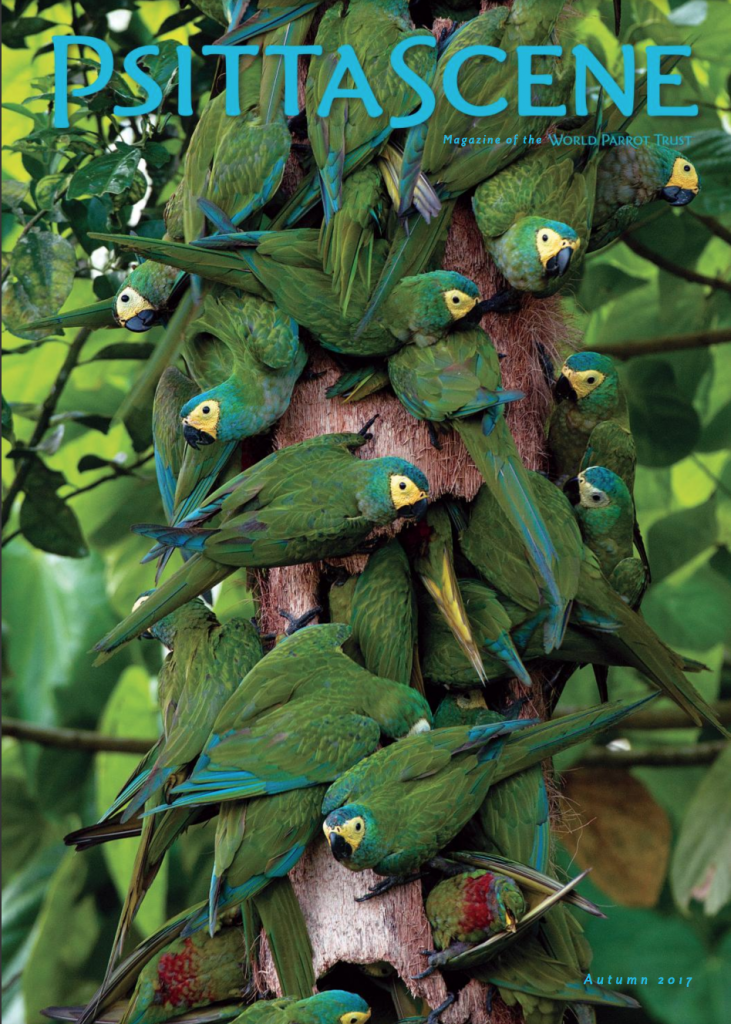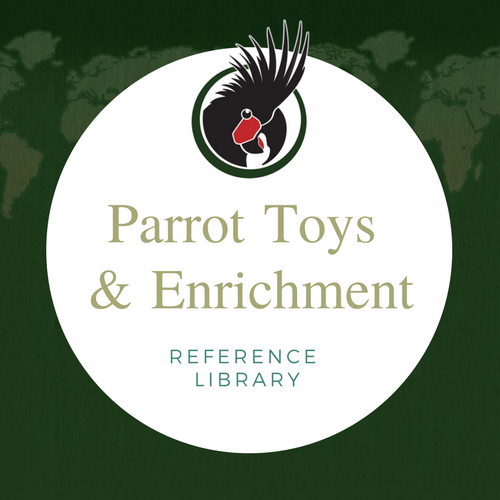
Hide & Seek
Foraging and Puzzle Toys for Parrots

Anyone who has had a companion bird for a length of
time will tell you that keeping that bright and
inquiring mind occupied is an al
most continuous job – a fun one,
but continuous. To come up with
new ideas can be a challenge in a day that is f
illed with other things:
work, family and other
necessities. Here are a few fora
ging and puzzle type enrichment items to remember/try out/plan
ahead for to keep the littlest bi
rdie ones in the family happy.
A parrot is built, mentally and physically, for foraging
Parrots in the wild spend a good deal of their time
seeking: food, shelter/roosting areas, nest sites,
and company. Parrots in captivity must somehow ma
ke up for the lack of
opportunity for all of
these natural inclinations, and it is up to us, thei
r caregivers, to fill in th
e gaps. Foraging or puzzle
toys are items that can keep them
busy, and are a good place to start.
Anyone who has had a companion bird for a length of time will tell you that keeping that bright and inquiring mind occupied is an almost continuous job – a fun one, but continuous. To come up with new ideas can be a challenge in a day that is filled with other things: work, family and other necessities. Here are a few foraging and puzzle type enrichment items to remember, try out and plan ahead for to keep the littlest birdie ones in the family happy.
A parrot is built, mentally and physically, for foraging.
Parrots in the wild spend a good deal of their time seeking food, shelter/roosting areas, nest sites, and company. Parrots in companion care must somehow make up for the lack of opportunity for all of these natural inclinations, and it is up to us, their caregivers, to fill in the gaps. Foraging or puzzle toys are items that can keep them busy, and are a good place to start.
Natural Browse & Other Items
Note: Always ensure you know exactly what species of plant you are dealing with. A natural toy item is a great fit for a bird historically used to being in the wild. Safety rules apply, for both toxicity and physical dangers such as barbs and spines. Also, in general, make sure the wood has not been exposed to exhaust fumes, rot, mould or insects. The following is a list of natural items:
Branches like fir, pine (sap and needle free), saskatoon, willow, aspen, sycamore, alder, beech, oak, pear, apple and grapevine (unsprayed), spruce, beech, ash, elm, hawthorn, poplar – again, be sure you can identify these species. Place on top of enclosure or through wire as perches. If possible heat sterilize in oven at 250F for an hour, or use F10 (available through your veterinary clinic) or vinegar solution to clean, then dry in hot sun (UV rays will help to sterilize, too).
Shrubs like saskatoon and apple when in bloom and let the birds pick the blossoms off.
Oat, wheat and cat grasses can be planted in indoor (or outdoor) pots for grazing. Cover with plastic mesh, or drop one pot into a deeper one to keep parrots from eating soil.

Pine or spruce cones are favourites of many birds. Heat sterilize at 200F for 20 minutes, shut off oven and let cool for two hours while still in oven. When ready to use, stuff favourite food items or other chewable toys in cones for foraging fun.
Safe plants include spider plant, jade, pony-tail palm, Swedish ivy, petunia, snap dragon, and nasturtium. Ensure potted plants do not develop mould in the soil. GSE solution (10-15 drops per gallon) used to water the plants every two to three weeks can help prevent this. Also make sure the pot itself is made of bird-safe materials.
Leafy vegetables such as kale, endive, edible flowering cabbage, carrot tops, corncob, dandelion, chickweed) are chewable, and also nutritious. They can be draped or interwoven through cage wire, tied in with other foraging branches or included in with existing toys.

It's a puzzler
Parrots are curious about most things. This is a trait that is present from youngster onwards, and is key to a parrot’s overall education about its environment. Part of this education is learning how to solve simple problems, such as opening a palm nut and extracting its contents. This activity is puzzle solving of a sort.
Companion parrots have the same curiosity. They need to be able to express this inquisitiveness and to learn, and can do so with puzzle toys that challenge them.
Note: Always supervise the use of new toys to ensure no injuries or other problems occur.
Puzzle Toys
– Simply filling a box with chewables and non-destructible items can make an effective puzzle toy, mixing the two together in a big jumble, and then having your parrot search through for its favourites.
‐ A segmented (partitioned) plastic box or hard plastic ice cube tray can be used the same way, by putting similar items in each section for the parrot to choose.

Cover boxes or food dishes with unbleached paper and tie on with raffia, paulie rope or seagrass rope. Slit a hole in the top so the bird can see what’s inside and let him rip it open to get at the goodies or toys.

Set up a tray of clean, polished display stones or raffia bunches with toys, nuts, seeds, air-popped corn and other food items mixed in to find.
Use unbleached, basket-style coffee filters to string together and hide treats.

– Balling up unbleached or brown paper wrap with surprise food and non-food items inside can provide stimulation.
– 3-inch Dixie cups (plain) or other bowls can be used to hide food items amongst non-destructible toys. These can be further covered with balled paper to make more of a challenge.
‐ Commercial type, hard (never soft) plastic foraging and hide-n-seek toys are available online. These can be filled with food items, suspended from the top of an enclosure and then cleaned later for repeat use. Small stainless steel pails are available for the same purpose.
‐ Use a plastic chain; each link stuffed with unbleached paper or Dixie cups, and within the paper or cups hide a treat. Suspend safely from cage or ceiling.
‐ Paper coin wrappers (clean, unused) can be stuffed with chewable toys or food items, then the ends twisted together for a simple puzzle.
These are just a few of the countless ideas to help keep your parrot companion happy and stimulated. Be inventive, but always consider safety first – if you do not feel completely comfortable with a toy, do not use it.
Sources:
Parrot Toys and Play Areas, Carol S. D’Arezzo and Lauren Shannon-Nunn, Crowfire Publishing, Springfield, VA, 2000.
Article: Natural Environmental Enhancement for Your Captive Birds, EB Cravens
Parrot Enrichment Activity Book 2.0 Kris Porter
Enriching Lives: One Parrot at a Time – by Paradise Park’s David Woolcock
© Copyright 2018 World Parrot Trust. All Rights Reserved.

